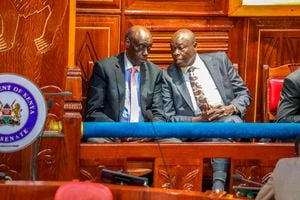
Kenya Power Managing Director Joseph Siror when he appeared before the Senate Energy Committee at Parliament Buildings Nairobi on October 17, 2023. PHOTO | DENNIS ONSONGO | NMG
|Business
Premium
Kenya Power sinks into Sh3.19bn loss on weak shilling
Kenya Power has reported a Sh3.19 billion net loss for the year ended June 2023 as it took a hit from a sharp rise in financing costs on its hard currency obligations due to the weakening of the shilling.
The Nairobi Securities Exchange (NSE)-listed utility says it could have reported a net profit of Sh3.26 billion in the year to June 2022, but an 89 percent jump in financing costs to Sh24 billion from Sh12.7 billion previously hurt its bottom line, despite a 12 percent rise in operating profit to Sh19.2 billion.
The loss is despite the higher tariffs that were meant to cushion it from the rising costs of doing business.
Kenya Power has reported net losses on only two other occasions in the past 20 years — Sh939 million in 2020 and Sh3.05 billion in 2003.
Companies that are highly exposed to foreign exchange debt or payment obligations, such as Kenya Power and Kenya Airways, are paying a steep price in the depreciation of the shilling by 17.9 percent against the dollar this year to exchange at 150.27 units.
The utility’s top line revenue grew by 21 percent to Sh190.98 billion, driven by higher power sales following the introduction of enhanced tariffs during the period. On the expense side, cost of sales rose by 22.4 percent to Sh143.57 billion on account of higher power purchase costs due to a rise in fuel prices.
“We had unrealised foreign exchange losses increase from Sh6.5 billion to Sh16.8 billion and this is the key driver in the Sh24 billion financing costs. There was also a significant increase in fuel prices, which applies also to the heavy fuel used in power generation,” said Kenya Power general manager-finance Stephen Vikiru.
“There was also an impact of the forex rate movement on power purchases, because we have about 65 percent of our cost of sales in foreign currency based on the contracts for independent power producers.”
Kenya Power’s hit came on the translation of the value foreign currency denominated obligations and assets to shillings rather than directly from exchange losses on interest payments that rose from Sh5.1 billion to Sh5.8 billion in the period given that most of its foreign loans are on concessional terms.
Reporting standards require that both loans and power purchase obligations at the end of the period be measured and translated to the reporting currency, in this case the shilling. The exchange gains or losses arising from this revaluation are then applied on the company’s profit and loss account.
The difficulties in accessing dollars deepened Kenya Power’s translated losses by delaying the settlement of obligations whose value subsequently rose further due to the depreciation of the shilling.
By the end of June 2023, Kenya Power’s cash balance increased to Sh18.4 billion from Sh8 billion in June 2022, pointing to difficulties in converting shillings to dollars.
“The increase in cash balance was due to two reasons. The business generated more cash this year, and because of the unavailability of foreign exchange to settle obligations, our cash holdings rose as we looked for dollars in the market,” said Mr Vikiru.
The utility is one of the largest corporate consumers of dollars in the country, requiring between $45 million and $50 million, and €18 million to €20 million per month to settle obligations.
The company’s loan book at the end of the period stood at Sh115.4 billion, split into commercial debt, and on-lent loans which are guaranteed by the government and on concessional terms; 94 percent of the loan book is in foreign currency.
The volume of on-lent loans stood at Sh70 billion plus an additional Sh9 billion arising out of a repayment moratorium offered by the government in June 2020. Commercial loans were valued at Sh35 billion.
The company is looking to offload some of the on-lent loans via a transfer of transmission assets to Ketraco.
Under the deal, the on-lent facility will be offset by the value of the assets, therefore transferring the debt to government, which owns 100 percent of Ketraco.





